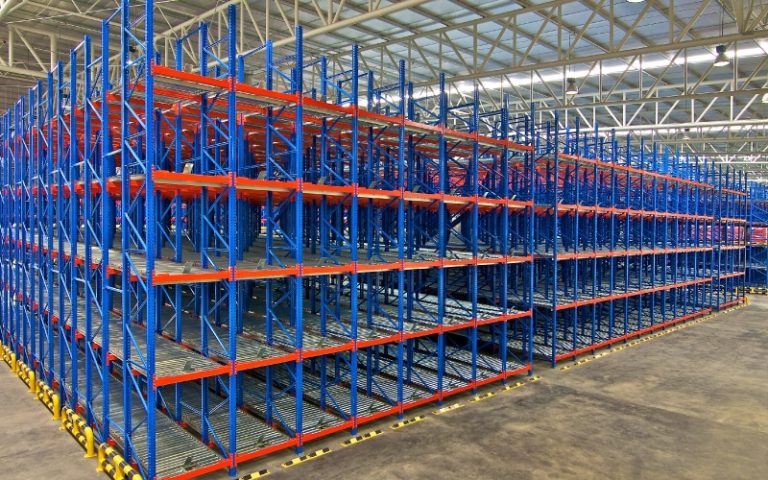The difference between a poorly designed warehouse and a functional, efficient one is significant. A bad layout, the wrong racks for warehouse storage, and poor workflow can tank your order cycle times, pick and pack rates, and item-per-hour metrics.
With a functional design and the right racks, storage warehouse management can accelerate your fulfillment and improve your profitability.
The Importance of a Functional Warehouse
How important is a functional warehouse? Let’s count the ways:
- Improved Efficiency: Streamlines operations, reducing the time it takes to locate, pick, and pack orders. This leads to faster delivery times and increased customer satisfaction.
- Cost Reduction: Inefficient warehouses can incur significant costs due to lost or damaged products, excess inventory, and dead stock. With the wrong racks, storage warehouse operations take longer to place and pick goods—adding to your travel time and labor costs.
- Enhanced Customer Service: A warehouse that can fulfill orders quickly and accurately delivers a better customer experience. That impacts customer retention and repeat business.
- Better Inventory Management: An efficient warehouse enables you to track inventory levels more efficiently—reducing carrying costs.
So, you might be asking: How do we design a more functional warehouse with the right racks for warehouse storage? Good question! Here are the key steps to get you started.
Designing a Functional Warehouse
A successful warehouse design begins with a comprehensive assessment of your storage needs.
Storage Needs Assessment
Conduct a thorough inventory analysis to understand your storage requirements. This involves evaluating the volume, size, weight, and type of items you need to store. Consider your SKU count and frequency patterns to determine optimal placement strategies.
Selecting the Perfect Racking System
Your racking system forms the foundation of your warehouse’s efficiency and can vary greatly depending on your storage needs and available space. Some of the most common racks for warehouse storage include:
- Selective Pallet Racks: Most common, offering easy access to any pallet on any level.
- Drive-In/Drive-Thru Racks: Ideal for high-density storage of similar items with first-in, last-out access.
- Push Back Racks: Efficient for bulk storage, with pallets pushed back as new ones are added.
- Flow Racks: Gravity-fed system for first-in, first-out inventory flow.
- Cantilever Racks: Suitable for long or bulky items like lumber or pipes.
Warehouse Layout Optimization
Your warehouse layout must prioritize efficiency and safety.
Start by taking precise measurements of your available space, including all structural elements like doors, columns, and loading docks. When designing aisles, ensure they accommodate your material handling equipment while maximizing storage density.
If space is at a premium, you could consider very narrow aisles (VNA) racks.
When you map your warehouse, pay attention to areas that could impact your layout and rack placement, such as:
- Clear height from floor to ceiling or lowest overhead obstacle
- Width and height of all doorways, including emergency exits
- Location and size of support columns
- Loading dock dimensions and quantity
- Office and administrative areas
- Utility access points and electrical installations
Keep in mind that HVAC, lighting, and sprinkler systems may require specific clearance, which can impact your storage placement.
Maximizing Vertical Space
Unused space is costly. You pay to heat, cool, and light it. So, let’s put it to use.
Consider implementing multi-tier racking systems where appropriate. Stack racks let you easily expand upward with the proper structural support. Mezzanines can also expand your storage vertically.
Equipment Considerations
The success of your warehouse design depends heavily on how well it integrates with your material handling equipment. Ensure your racking systems align with your forklift specifications and provide appropriate clearance for reach trucks if you’re utilizing vertical space.
Safety Implementation
Of course, safety is paramount. Make sure the racks for warehouse storage meet your safety requirements and conform to industry standards and OSHA regulations. Safety should be part of your daily operations, including making sure your workers understand (and conform to) the manufacturer’s load capacity specs for each rack level.
Maximizing Your Investment
The key to a functional warehouse is a flexible system that can adapt to changing needs over time. So, getting guidance from the material handling experts at Conesco Storage Systems is a smart idea. With expert warehouse planning and the right racks for warehouse storage, you can build a functional and versatile warehouse operation to maximize your investment.
As one of the nation’s leading suppliers of new and used warehouse racking systems and material handling equipment, Conesco Storage Systems can help you plan and build out your warehouse with exactly what you need for today’s workflow and whatever comes next.
Call Conesco Storage Systems at (303) 690-9591 or request a free consultation online to discuss your warehouse needs.



